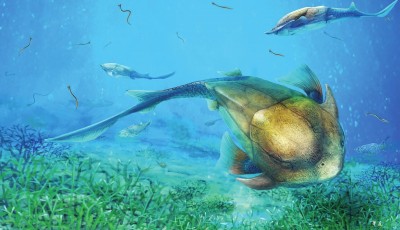Yunnan found 423 million years ago the ancient fish, strange, possibly human ancestor | people | | fish _ China News
 Long Kiss Unicorn fish restoration plan.
Long Kiss Unicorn fish restoration plan. Original title: Mystery of the source of Chinese ancient fish fossil reveals the human jaw bone
Xinhua News Agency, Washington D.C., October 20 (reporter Lin Xiaochun)-as an important part of the face, jaw how humanity evolved? In China, Yunnan discovered an ancient fish fossil provides updated answers: human jaw can be traced back to 400 million years ago, a "wearing helmets with" prehistory of raw fish.
The CAS Institute of vertebrate paleontology and Zhu min team Sweden Uppsala University, peier·aerbeili research team, published in the latest issue United States the journal Science, were considered "sweep away our understanding of the evolution of the vertebrate jaw a big blind spot."
Human jaw is located in the edge of the mouth, which does not seem complicated. But in fact, they are tortuous and complex evolution that eventually became today's appearance. JAWS was first made up of cartilage in the body, but in the long evolutionary process, a series of bone from the body surface (membrane bone) joined in, eventually replacing the cartilage-derived primitive jaw.
Fish due to wear heavy armor and shield skin gets its name, is the late Devonian period, namely "age of fishes" (approximately 4. 1.9 billion to 3. 5.9 billion years ago), ruler of the seas, rivers and lakes. JAWS first appeared in the shield in the skin of fish, which became the major turning point in the history of early vertebrate evolution. Typical of the shield has 3 simple membranous skin fish jaws, are located on the inside of the mouth, and facial bones are not connected, called "the jaw".
Zhu min told Xinhua that, traditionally, simple membranous placoderm jaws and bony vertebrates, including humans, are called "JAWS" complex membranous jaws are different sources, but this recognition because they reported in 2013 in Qujing, Yunnan province discovered placoderm and radical change of the jaw.
Yunnan Qujing has "lost Kingdom of ancient fish," said, holds a variety of strange primitive fish fossils here. JAWS found in Qujing placoderm body typical of placoderm, and long bony fish jaws, clearly show the bony fish evolved from shield skin fish directly. Humans are later offspring of bony fish on the land, also traces back to a human jaw jaw placoderm.
But placoderm jaws and jaw where it come from? Zhu min said that previous fossil evidence does not support them with more primitive placoderm membranous contact on the evolution of the jaw, jaw between the jaw and the existence of "significant morphological divide", it was speculated that there might be generating too much restructuring.
Now, they report in qilin district of Qujing city found 4. 2.3 billion years ago a jaw of Unicorn fish placoderm-long kiss. This small fish is about 20 cm long, with dolphins that reach the rostrum and uplift the "forehead", mouth and nostrils are located on the ventral surface, half a body covered with box-like bony plates.
High-accuracy analysis of three-dimensional reconstruction CT scan and display, Unicorn fish has a pair of "incomplete jaw", its jaw jaw fish fish and other more primitive shields skin transitions between States. This shows that is the original jaws of the jaw evolved gradually, and not as used to think after major restructuring.
According to the findings, the researchers presented new theory of evolution from the jaw to jaw: shield 3 fish on the displacement of jaw bone on the inside to the outside, into a full State 3 lateral edges of the jaws of the jaw. "Thus, we forward has been traced back to the most primitive human jaw can shield the skin of fish," Chu said.
Science magazine issued in the same period of the society of vertebrate paleontology in North America Chairman, Australia Flinders University yuehan·lang entitled jaws of the early commentary said: "for a long time, shields the skin of fish is not evolutionary biologists attention, however the series from China found to change this perception, shows shields skin fish become the key to understanding the evolution of the vertebrate body structure. ”
Responsible editor: Chen yan SN225
Article keywords:Evolution of human fish in China
I want feedback
Save a Web page
Xinhua
云南发现4.23亿年前古代鱼类,长相怪异,可能是人类远祖|人类|鱼类|中国_新闻资讯
 长吻麒麟鱼复原图。
长吻麒麟鱼复原图。 原标题:中国古鱼化石揭示人类颌骨来源之谜
新华社华盛顿10月20日电(记者林小春)作为面孔的重要组成部分,人类的颌骨如何进化而来?在中国云南发掘的一种古鱼化石提供了最新答案:人类的颌骨可以追溯到4亿年前一种“披盔戴甲”的史前原始鱼类。
这项由中科院古脊椎动物与古人类研究所朱敏团队与瑞典乌普萨拉大学佩尔·阿尔贝里团队合作开展的研究发表在最新一期美国《科学》杂志上,被认为“扫除了我们在脊椎动物颌演化认识上一个大的盲区”。
人的颌骨位于口的边缘,其构造似乎并不复杂。但实际上,它们经过了曲折复杂的演化历程,才最终变成今天的样子。颌骨最早由体内的软骨组成,但在漫长的演化历程中,一系列来自体表的骨片(膜质骨)加入进来,最终取代了软骨来源的原始颌骨。
盾皮鱼类因身披笨重盔甲而得名,是泥盆纪,即“鱼类时代”(大约4.19亿年至3.59亿年前)海洋、河流与湖泊的统治者。颌最早就出现在盾皮鱼类中,这成为脊椎动物早期演化史上的重大转折。典型的盾皮鱼类有3对简单的膜质颌骨,都位于口腔内侧,与面部其他骨骼并不相接,称为“原颌状态”。
朱敏对新华社记者说,传统上认为,盾皮鱼的简单膜质颌骨与包括人类在内的硬骨脊椎动物的被称为“全颌状态”的复杂膜质颌骨是不同源的,但这一认识因他们2013年报告的在云南曲靖发现的全颌盾皮鱼而彻底改变。
云南曲靖有着“失落的古鱼王国”之称,这里保存着多种奇怪的原始鱼类化石。在曲靖发现的全颌盾皮鱼身体保持着典型盾皮鱼的样子,却长着硬骨鱼类的上下颌,明确显示出硬骨鱼类由盾皮鱼类直接演化而来。人类是后来登上陆地的硬骨鱼类的后代,人类的颌骨也因此向前追溯到了全颌盾皮鱼。
但全颌盾皮鱼的颌骨又从哪里来?朱敏说,此前的化石证据不支持它们与更原始的盾皮鱼的膜质颌骨有演化上的联系,全颌与原颌两者之间存在着“巨大的形态鸿沟”,有人推测其间可能产生过大重组。
现在,他们报告在曲靖市麒麟区发现了4.23亿年前的一种全颌盾皮鱼——长吻麒麟鱼。这种小鱼长约20厘米,具有海豚那样前伸的吻突和隆起的“额头”,口和鼻孔都位于腹面,大半个躯体包覆着箱形的骨甲。
高精度CT扫描和计算机三维重建技术分析显示,麒麟鱼具有一副“不完全的全颌”,其颌骨处于全颌鱼和其他更原始盾皮鱼类之间的过渡状态。这表明,全颌是原颌渐进演化而来的,而非像过去认为的那样经过大重组。
根据这一发现,研究人员提出了从原颌到全颌的演化新理论:盾皮鱼类的3对内侧颌部骨骼向外位移,变成了全颌状态中的3对外侧边缘颌骨。“由此,我们人类的颌骨可以向前一直追溯到最原始的盾皮鱼类,”朱敏说。
《科学》杂志同期配发北美古脊椎动物学协会主席、澳大利亚弗林德斯大学约翰·朗题为《颌之初》的评论文章说:“长期以来,盾皮鱼类不大受演化生物学家重视,然而来自中国的系列发现正改变这一认知,显示盾皮鱼类成为理解脊椎动物的身体结构如何演化的关键。”
责任编辑:陈琰 SN225
文章关键词: 人类 鱼类 中国 演化
我要反馈
保存网页
新华网